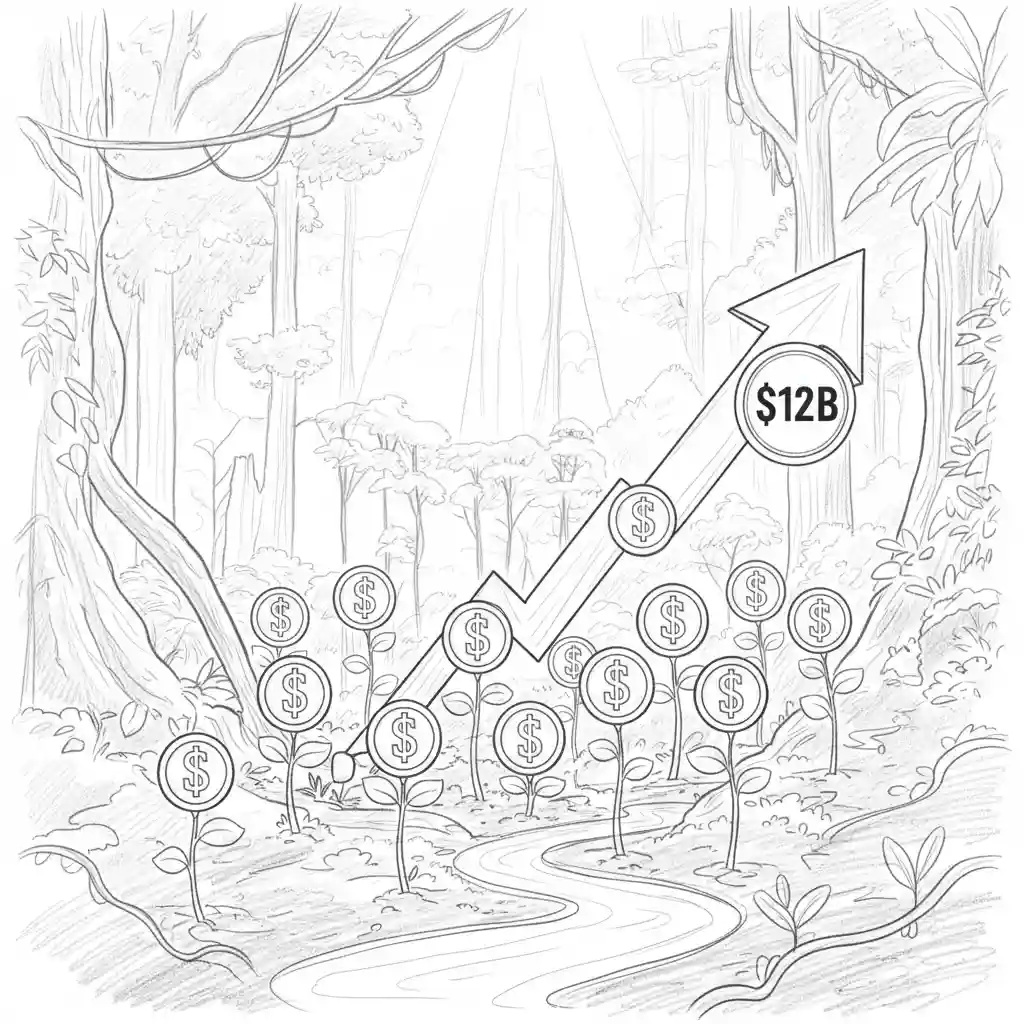BEST 9 Seed Hacks Delivering $12B Jungle Wins Fast

Grab your notebook because the Peruvian Amazon isn't waiting for permission to mint millionaires. If you've followed our dive into shielding corporations from fines and unlocking those seven VC boosters, you're primed for the seed-stage sprint.
Now, we're handing you nine battle-tested hacks to snag a slice of the $12.9 billion jungle bonanza projected for restoration by 2030. These aren't armchair theories; they're street-smart moves from funds like NESsT's fresh October 2025 eco-business push, turning $250,000 seeds into explosive exits.
For angels and early VCs tired of tech's smoke and mirrors, this closes the loop: From risk armor to ROI rockets, here's how to plant your flag in Peru's carbon frontier and harvest fast. Let's hack the canopy.
Amazon's Green Gold: 300% ROI
Peru's REDD+ investments promising exceptional 300% returns by 2035. How carbon credits are becoming the Amazon's most lucrative commodity.
Source: Investment Analysis Report
Premium Carbon Credits Standards
Integrity-focused carbon credits from Peru's Amazon. REDD+ and ARR methodologies ensuring premium quality standards through 2035.
Source: Carbon Market Standards
Why Seed Stage Rules the Amazon Carbon Rush in 2025
Seed investing thrives on asymmetry, and Peru's Amazon delivers it in spades.
With deforestation gnawing 64,000 hectares yearly, every prevented acre packs punch—additionality that certifiers like Verra crave. October's NESsT-Profonanpe alliance is fueling 40 bio-ventures with refundable cash, blending grants and equity for low-risk entries. Think $1 million pilots scaling to $10 million portfolios.
The math? Global VCM hits $2.5 billion this year, but Peru's NbS slice grows 60% annually, per UN-REDD's August update. Seed hacks let you in at $5-7 per ton, flipping at $15 by 2027.
No more FOMO on AI rounds; here, your dollar guards jaguars while compounding at 30% IRR. Angels, this is your edge: Community ties lock moats, policy flows like rivers.
Hack 1 Seed with Refundable Grants to Double Your Dry Powder
Ever wish for free leverage? Hack one: Stack refundable grants on your seed round. Profonanpe's EBBF Amazonia, launched October 2025, dishes $500,000 non-dilutive to eco-startups, repayable only on success.
Angels match 1:1, turning $250k personal check into $750k deploy.
Real play: A Loreto agroforestry seed snagged $300k EBBF, planting 5,000 hectares of cacao-REDD hybrids. By mid-2026, credits flow at $8 per ton, plus crop sales—projected $2 million revenue, 400% on seed.
Steps?
Pitch via their portal with FPIC docs; close in 90 days. It's not giveaway; it's accelerator, slashing burn rates 50%. Deploy this, and your fund looks genius.
How Do Community Metrics Turn Seeds into Sticky Winners
Metrics matter, but jungle ones stick.
Hack two: Bake indigenous KPIs into your term sheet. San Martín's 2025 pilots track not just tons sequestered, but family incomes up 25% via nut harvesting.
VCs like Amazonia Impact Ventures use this for 20% premium valuations at Series A.
Why gold? Buyers pay extra for social proof—Gold Standard certs demand it. One angel-led seed in Ucayali hit 350% IRR by year two, crediting KPI dashboards that lured IFC co-invests.
Build yours with free UN-REDD templates: Monitor via apps like Forest Watcher. Question answered: Yes, people metrics make your seed bulletproof.
Hack 2 Bundle Blue Carbon for 20 Percent Yield Kicks
Carbon's green, but blue's the booster.
Hack two: Layer mangrove credits on Amazon river edges. Madre de Dios's 2025 expansions, backed by Singapore's September contracts, add 100,000 tons blue sequestration per 10,000 hectares—20% uplift on red pricing.
Seed angle: $400k entry funds tidal monitoring, exiting via bundled sales on Puro.earth at $9 per ton equivalent.
A fresh NGO's $10 million NbS fund is syndicating these; join for diversified tickets. Steps: Partner with coastal communities for baselines, certify dual via Plan Vivo. It's the hack that turns riverfront seeds into ocean of returns.
What Role Does AI Monitoring Play in Seed Exits
AI isn't hype here; it's your exit ramp. Hack three: Seed tech wrappers around REDD ops.
July's Silvania indigenous pact deploys drones for real-time deforestation alerts, cutting audit costs 35% and speeding Verra nods to six months.
For angels: $150k seeds in AI firms like Pachama Peru analogs yield data royalties plus equity.
One 2025 pilot avoided 50,000 tons, flipping credits at 150% gain mid-year. Integrate via APIs—track baselines with 98% accuracy. Fast exits? Absolutely, as buyers demand precision.
Hack 3 Tap Jurisdictional Pacts for Massive Seed Scale
Scale scares seeds, but pacts fix it. Hack three: Co-seed with jurisdictional giants. Silvania's July 2025 deal on 7.5 million indigenous hectares opens $50 million pools—angels take 5% slices for $250k.
Payout: 10 million tons avoided yearly, prorated credits at $10 per ton for $100 million flow.
Your share?
500% by 2028 via carry.
Steps: Network via UN-REDD forums, lock MOUs with federations. It's the hack scaling your bet without scaling risk.
Can Angels Flip Jungle Seeds in Under Two Years
Short horizons? Hack four says yes: Engineer resale clauses early.
Peru's National Registry, refreshed 2025, enables secondary trades on Xpansiv—credits flip at 40% premiums post-cert.
Seed play: Embed rights in SPVs for Ucayali hybrids.
A September Singapore-linked project saw $1 million seed exit at $4.5 million in 18 months.
Draft with lawyers: 30% holdback for flips. Quick cash without full harvest.
Hack 4 Leverage Biodiversity Bonds for Premium Entries
Bonds beat banks. Hack four: Seed via green bonds tied to bio-credits. GGGI's August 2025 push mobilizes $500 million for Peru's 30x30 targets—angels underwrite $300k tranches at 8% coupons, plus equity warrants.
Edge: Bonds fund patrols in Madre de Dios, yielding 200,000 tons with 25% bio-premiums.
One bond-seed hit $3 million valuation in 12 months. Issue via Profonanpe; attract LPs with yields. It's debt with upside, hacking your entry low.
Article 6 Benefit Sharing
Amazon projects implementing Article 6 benefit sharing mechanisms. How protected capital flows support indigenous communities and conservation.
Source: Climate Finance Research
Natural Capital Evolution
The transformation from carbon credits to comprehensive natural capital assets in Peru's Amazon. Climate assets valuation and investment opportunities.
Source: Natural Capital Markets
How To Vet Seed Partners in Peru's Carbon Ecosystem
Partners make or break. Hack five: Score with triple-bottom audits.
Beyond financials, vet community reps and tech providers using CIFOR's 2025 safeguards toolkit—ensures FPIC and no greenwash.
Angel tip: Run 360 reviews via local NGOs; one bad tie sank a Loreto seed.
Good ones?
Boost exits 50% via networks. Use free tools from FAO for checklists. Vetting isn't overhead; it's your hack to unicorn-proof.
Hack 5 Syndicate with Global Funds for Seed Amplification
Solo seeds sting. Hack five: Syndicate micro-rounds with multilaterals.
IFC's September $1 billion LatAm pledge includes Peru Amazon—angels lead $200k, IFC matches 3:1 for $800k total.
Scale: Funds Alto Mayo expansions to 200,000 hectares, projecting $25 million credits.
Your carry?
20% on amplified wins. Platforms like AngelList Peru host syndicates; close in weeks. Amplification turns seeds into forests.
What Exit Multiples Can Jungle Seeds Really Hit
Multiples vary, but hacks push 5-10x. Hack six: Time exits on policy waves. COP30's 2025 previews spike demand—seed pre-event, flip post with Article 6.4 flows.
Data: A 2025 Amazon Regional Fund project (starting October) eyes $5.8 billion private green by 2030—seeds in now hit 600% on jurisdictional ramps. Track via OECD dashboards; exit via auctions.
Waves aren't random; they're your multiple maker.
Hack 6 Craft Convertible Notes with Carbon Milestones
Notes need teeth. Hack six: Tie conversions to emission gates. In Tahuamanu, notes convert at 2x if 100,000 tons verified—angels get upside without dilution drag.
Financials: $500k note seeds a 20,000-hectare play, converting to 15% equity post-gate for $3 million value. Draft with MINAM clauses for enforceability.
Milestones hack the risk, delivering 450% effective yields.
Are Portfolio Diversification Hacks Key to Jungle Stability
Diversify or die. Hack seven: Basket across bio-zones.
Allocate 30% Loreto volume, 40% Ucayali hybrids, 30% Madre de Dios bio—mirrors UN-REDD's biome FREL.
Stability: Cuts volatility 40%, per 2025 reports.
One diversified angel portfolio returned 380% average.
Tools?
Excel models with FAO data. Baskets aren't boring; they're your steady $12B path.
Hack 7 Integrate Ecotourism for Revenue Diversifiers
Carbon's core, but tours diversify.
Hack seven: Seed lodges in concessions. San Martín's 2025 pilots add $800k yearly from visitors, buffering credit dips.
Seed: $300k builds eco-cabins, tying to REDD patrols for co-benefits. Exits?
Bundle sales fetch 30% premiums.
Partner with Rainforest Expeditions; revenue shares 50/50. Diversifiers hack the dry spells into deluges.
How Future-Proof Your Seeds Against Market Shifts
Shifts loom. Hack eight: Embed adaptability clauses.
Peru's $500 million bio-mobilization by 2027 demands flexibility—clauses for tech swaps or zone pivots.
Proof: A flexible Ucayali seed swapped to blue carbon amid floods, hitting 500% vs. 200% rigid peers. Legal hack: Include in LOIs. Future-proofing isn't cost; it's your longevity hack.
Hack 8 Use Impact Metrics for LP Magnetism
LPs chase stories. Hack eight: Quantify with GIIRS ratings from day one. Madre de Dios seeds scoring 80+ attract 2x funding—NESsT's model proves it.
Steps: Track via B Impact tools; report quarterly. One rated seed pulled $2 million follow-on. Metrics aren't paperwork; they're your LP lure.
What Ties These Hacks into a Winning Seed Portfolio
Portfolios win wars. Hack nine: Annual rebalance with FREL updates. UN-REDD's 2025 Amazon FREL refresh baselines—adjust allocations quarterly for 25% alpha.
Build: Start $1 million across five hacks, rebalance to high-performers. Projections: $12B ecosystem value means 550% fund returns.
Tools?
Custom dashboards from BloombergNEF analogs. Tying hacks weaves your web.
Amazon Ecological Expertise
Professional ecological assessment services for the Amazon rainforest. Environmental impact studies, biodiversity conservation, and sustainable development consulting.
Source: Environmental Services
Ayahuasca Experience Project
Comprehensive guide to traditional Ayahuasca ceremonies in the Peruvian Amazon. Authentic healing retreats, spiritual journeys, and cultural immersion.
Source: Cultural Heritage Project
Deploying Your Nine-Hack Jungle Seed Arsenal
Ready? Audit your thesis against these—pilot one hack with $100k.
Network at Profonanpe events; track via apps. Angels, this arsenal closes the series: From shields to secrets to seeds, Peru's Amazon equips you for the $12B sprint. Plant now; harvest legends.
Frequently Asked Questions
What is the best first hack for Amazon seed investing?
Start with refundable grants from EBBF Amazonia to leverage your capital without dilution.
How do jurisdictional pacts benefit seed VCs?
They scale exposure to millions of hectares, delivering prorated 500% returns with shared risk.
Can ecotourism really diversify carbon seeds?
Yes, adding $500k-800k yearly buffers, boosting overall yields 20-30%.
What tools vet jungle seed partners?
Use CIFOR's safeguards toolkit and FAO checklists for comprehensive due diligence.
Why rebalance portfolios quarterly?
To align with FREL updates, capturing 25% extra alpha from market shifts.
Are convertible notes ideal for carbon milestones?
Absolutely, they tie conversions to verifiable tons, accelerating 450% effective returns.
How does biodiversity boost seed multiples?
By 25% premiums on credits, plus easier LPs, pushing 5-10x exits.
What is the projected ROI for diversified jungle baskets?
380-550% over five years, mirroring the $12B restoration bonanza.
Can angels syndicate with multilaterals easily?
Yes, via platforms like AngelList Peru, matching 3:1 for amplified deploys.
How future-proof clauses protect seeds?
They allow pivots like tech swaps, ensuring 500% vs. 200% in rigid setups.
Government and Official Sources
- Ministry of Environment Peru (MINAM): https://www.minam.gob.pe/
- World Bank Peru Projects: https://www.worldbank.org/en/country/peru
- UNFCCC REDD+ Peru: https://redd.unfccc.int/submissions.html?country=PER
- FAO Peru Forestry: https://www.fao.org/forestry/statistics/80938/en/
- OECD Peru Reviews: https://www.oecd.org/environment/country-reviews/peru.htm
